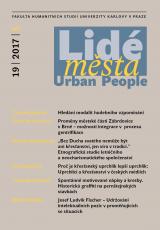Zdvořilý řečový habitus jako sociokulturní regulativ vztahové sítě. Hledání antropolingvistické definice řečové zdvořilosti a jejího funkčního rozpětí
Polite Speech Habitus as Socio-cultural Regulator of Social Network. Searching for a Linguistic Anthropological Definition of Speech Politeness and its Functional Range
Author(s): Miroslav SlowikSubject(s): Anthropology, Language and Literature Studies
Published by: Univerzita Karlova v Praze - Fakulta humanitních studií
Keywords: politeness; regulative function; verbal behavior; evaluative mechanism
Summary/Abstract: The article aims to monitor the functional range of communication and speech based on the essence of language markets in geographically and politically different social configurations. Speech behavior, which is part of all human interaction with other people, is a very broad phenomenon, and one of its modularities is the specific area that we call speech courtesy or politeness. Speech politeness is one of the characteristics of human behavior in society, and arises from the need to respond to the structure of this society, to relationships between individuals, to social stratification, and to archetypal standards of behavior; all of this is then reflected in the language by coded entities that reveal trends in social mobility, as well as in the type of social modalities of linguistic ethnicity. However, this is not just a phenomenon that arises as a reaction, reflecting the aforementioned cultural and social facts in merely one way; it is also a phenomenon that shapes and maintains the structure of society, its stratification, and the relationships between individuals itself. Speech politeness is thus an immanent part of all linguistic behavior of man, and one can observe its characteristic aspects, which are either i) common for the studied linguistic communities or ii) different, which then appear as distinctive features of two culturally linguistic formulas.
Journal: Lidé města
- Issue Year: 19/2017
- Issue No: 3
- Page Range: 355-371
- Page Count: 17
- Language: Czech

